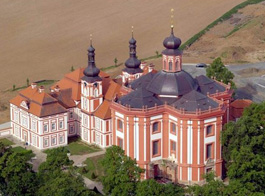
In northern Plzeň, they want to be on the UNESCO list, activities are starting
 |
| Mariánská Týnice |
"Mariánská Týnice, the Plasy complex, and the entire property of the Cistercian monastery is a cultural landscape that can certainly compare to the Lednice-Valtice area, which is already a protected cultural landscape by UNESCO," she said.
According to her, work on promoting the area for the prestigious list has already begun, and it is important to start by talking to locals, explaining to them what a treasure they have near their homes. "We must explain that it's not about stifling the economy, but rather about bringing more order to the area and making the landscape harmonious again, as it was in the past. The challenge is enormous," she stated.
The architect reminded that there is a landscape conservation zone in the area, which is not entirely properly defined. "There should be a redefinition of the zone, so that it touches the old Plasy road more, which is awaiting its restoration," she added. The restoration of the Plasy road is part of the landscaping projects for Plzeň 2015. Salzmann has already informed the National Heritage Institute about the effort, which she says has agreed with the idea, and Plzeň Region also reportedly supports it.
The cultural landscape should be located in the space along the axis of Plasy, Mariánská Týnice, and Hubenov, where 13 farms were composed almost alchemically. A large number of Baroque buildings in the area are from the famous architect Jan Blažej Santini.
According to Irena Bukačová, the director of the museum in Mariánská Týnice, the Plasy monastery managed the landscape for 600 years, during which time landscape connections were established between individual places housing buildings. "The monastery itself built a number of churches and chapels that are still dominant features of the villages, such as the chapel in Mladotice or the pilgrimage site in Mariánská Týnice, which gives the landscape a spiritual character," she stated.
Bukačová noted that there is also an association called Santini interested in key landmarks in the northern Plzeň region, namely the buildings by Santini. It brings together owners, users, and managers of the elite buildings constructed by this architect and aims to declare selected Santini monuments across the country as a dispersed UNESCO monument. "A similar model has been used in Romania, where Orthodox wooden churches are protected in various locations," Bukačová stated. According to her, the more efforts that are made in this respect, the easier it will be to bring the initiative to a successful conclusion.
The English translation is powered by AI tool. Switch to Czech to view the original text source.
0 comments
add comment











